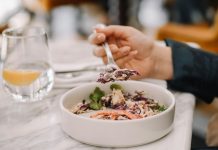
In a new study, researchers found that sugar consumption is linked with larger fat deposits around the heart and in the abdomen, which are risky for health.
They found this fat tissue located around the heart and in the abdomen releases chemicals into the body which can be harmful to health.
The results support limiting added sugar intake
The research was conducted by a team at the University of Minnesota.
Excess sugar consumption is a worldwide problem. The six countries with the highest sales of sugary drinks per capita are Chile, Mexico, Argentina, Peru, the US, and Saudi Arabia.
The demand for sugar is expected to increase in Asia, Africa, and Russia.
This study examined both sugar-sweetened beverages (such as soft drinks, fruit drinks, energy drinks) and sugar added to foods and beverages for sweetness (for example when cooking or in processed foods).
The researchers analyzed the association between long-term sugar consumption and fat stores around the heart and other organs.
Data were obtained from a total of 3,070 healthy Americans aged 18 to 30.
Food and beverage intakes were measured three times over a 20-year period (1985 to 2005).
After 25 years (in 2010) computed tomography (CT) scans of the chest and abdomen were performed to measure fat volumes in the abdomen and around the heart.
The researchers found that sugar intake over the 20-year period was related to fat volumes later in life.
Higher intakes of both sugar-sweetened beverages and added sugar were related to greater fat stores around organs in a stepwise fashion.
The findings provide more evidence that consuming too much added sugar and sugary drinks is related to a higher amount of fat tissue.
These fat deposits are connected with higher risks of heart disease and diabetes.
The team advised reducing the amount of added sugar consumed each day.
Have water instead of sugary drinks and choose healthier snacks over foods rich in added sugar like cakes.
Read food labels to check the amount of added sugar in what you are buying. Pay attention to ingredients like syrups, glucose, fructose, sucrose, and maltose.
On top of our individual efforts, governments, food manufacturers, restaurants, schools, and workplaces have a role to play in increasing consumer awareness of the sugar content in foods and beverages and offering healthier alternatives.
One author of the study is Ms. So Yun Yi, a Ph.D. student at the University of Minnesota School of Public Health.
The study is published in the European Journal of Preventive Cardiology.
Copyright © 2020 Knowridge Science Report. All rights reserved.



